Danny Green's rise to two-way wing another cog to keep Spurs way intact

Over the past few years, as the Spurs have seemingly nudged closer to their current core’s expiration date, a specific, if predictable, form of curiosity about the franchise’s offseason plans has taken root. Are Tim Duncan and Manu Ginobli finally set to retire? Has Tony Parker lost a step? Can San Antonio cobble together another functional cast of role players? The Spurs proceed to answer these questions by finishing near the top of the Western Conference standings and embarking on deep postseason runs. San Antonio’s position in 2015 bears resemblance to that in years past, only reports indicate it also stands poised to vie for an A-list free agent in Blazers forward LaMarcus Aldridge.
The rampant speculation runs counter to the relative quiet associated with the Spurs’ recent summer personnel maneuverings. Whether San Antonio can realistically aspire to land Aldridge—and the salary cap space it would take to execute the move—has taken precedent in an offseason defined by a semi-awkward salary cap climate and fairly unremarkable crop of players on the move. If the Spurs do pull it off, they can thank Danny Green. Not only did Green’s contract situation present the potential to hinder, or at the very least complicate, the Spurs’ pursuit of a marquee big man, he may have commanded more lucrative contract offers had he decided to bide his time on the open market.
Green, 28, reportedly agreed to a four-year, $45 million deal with San Antonio on Wednesday.
• MORE NBA: Grade Green deal | Free agent grades | Off-season signings
That’s a freaking steal, but perhaps we shouldn’t have expected a different outcome. Green recently told the San Antonio Express-News that the Spurs “have expressed that they’d love to have me back and I’d love to be back,” while adding that he hopes he can “capitalize on I guess what you’d call a career peak.” It’s not difficult to see how those two priorities could have undermined one another. The Spurs, by all accounts, wanted to retain Green, and there were no indications he would have been opposed to signing on to play for one of the best-run organizations in the league, under the guidance of its best coach, for a few more years. Of course, the reality seemed at least seemed more complicated than that.
It wasn’t. San Antonio handled its business with Green less than 24 hours after the start of the free agency period (teams and players cannot consummate deals until July 9).
Green reportedly had multiple suitors from both conferences, including the Mavericks, the Blazers, the Pistons and the Knicks. Depending on how the Spurs planned to go about filling the rest of their their cap sheet—and to a lesser extent their urgency to chase Aldridge—several teams were likely to present Green with offers that eclipsed whatever San Antonio could fork over. That meant Green needed to weigh his affinity for and comfort with the team that helped groom him into a top-shelf 3-and-D threat versus his desire to get paid. It also left open to interpretation the level of compensation Green should have commanded and whether that squares with the deal he eventually did sign.
The general assumption at the end of the season that it was only a matter of weeks before Green would be cashing an eight-figure paycheck glosses over how close he came to being washed out of the league. He was selected in the second round of the 2009 draft by the Cavaliers after playing second fiddle to Tyler Hansbrough, Ty Lawson and Wayne Ellington on North Carolina’s 2009 national championship team. Green then appeared in only 20 NBA games as a rookie and logged two contests with the Development League’s Erie BayHawks before being waived prior to the start of the next season in favor of Manny Harris. The Spurs took a flier on Green in November 2010, only to cut him less than a week later.
Grade the deal: Warriors lock up Draymond Green with five-year deal
San Antonio reportedly didn’t think Green would fit in with the team’s culture and was put off by his attitude. Green practically begged Popovich for another opportunity. "I'll do whatever you need me to do,” Green remembered telling Popovich in a voicemail, according to ESPN. “Rebound, defense, towel boy, water boy … whatever you need me to do, I'm going to do that."
That marked the low point of a career that saw Green latch on with the Spurs later in the season and start 38 games the following year before earning his first multi-year, fully guaranteed contract (three years, $12 million). He’s since developed into one of the league’s premier wings. Green is best known for breaking the Finals three-point record and making an unlikely case for series MVP, but he also deserves recognition for his consistency: He’s started 96% of the 229 games he’s appeared in over the last three seasons and only once over that span missed extended time due to injury. Still, Green’s appeal can be boiled down to two core traits: three-point shooting and perimeter defense (we’ll get to that later).
He ranks sixth among qualified active players in outside shooting percentage, and has finished in the league’s top 10 in three-point makes in each of the last three seasons. Green’s long-range marksmanship is rarer still because of his size and age; there are only two players 6’6’’ or taller and under 29 years old who have attempted a minimum of 700 threes and connected on a 40% clip or better over the last four seasons, according to basketball-reference. One of them is Klay Thompson, whom the Warriors maxed out last October. The other is Green. Khris Middleton would check all those boxes had he launched 100 more threes between 2011-2015, and the Bucksjust rewarded him with a five-year, $70 million deal.
In San Antonio, Green has thrived as a roving floor-spacer alongside Kawhi Leonard, Parker, Duncan and Ginobli. There are few sights more terrifying for an opponent than a shoddily contested Green three. His mere presence on the perimeter forces concessions in coverage, as defenders must account for the possibility of a quick ball reversal or action to free up space for Green. The Spurs wisely have deployed him in a capacity that leverages his deep-shooting proficiency. More than 60% of Green’s attempts in each of the last three seasons have come from beyond the arc and canned nearly half of his tries from the corners. Green also ranked in the league’s 95th percentile in jump shot efficiency in 2014-15, according to Synergy Sports,
Lose track of Green on the break, and your best bet is to turn around, shake off the mistake and start trudging back up the court:
• MORE NBA: Latest signings | Kings, Sixers trade | Pierce to Clippers
Green has performed admirably as a complementary scorer within a system in which his chief responsibility perfectly aligned with his greatest strength. His range of offensive responsibility was narrow, and for good reason. Green is far from a prolific shot creator. According to SportVU tracking data, more than 77% of his shot attempts last season classified as either jumpers or pull-ups. When asked to put the ball on the deck as part of perhaps the modern NBA’s defining offensive set, the pick and roll, Green underwhelmed. In the 57 possessions in which Synergy logged Green as a pick-and-roll ball handler last season, he converted only 17 field goals, averaged 0.7 points and turned it over 14% of the time.
On the other end of the floor, Green is considered an elite stopper. He can stay in front of opposing ball handlers, does well to recover to contest shots, maintains his composure on closeouts and is surprisingly disruptive. Among shooting guards who logged at least 300 minutes last season, only K.J. McDaniels posted a higher block percentage. Unsurprisingly, the Spurs have yielded fewer points per trip during Green’s floor time, and he ranked seventh at his position last season in ESPN’s defensive Real Plus-Minus. Yet what distinguishes Green from others is his ability to check virtually every perimeter position. At 6’6", 215 pounds, he’s strong enough to provide resistance against bigger wings and can hold up against quicker guards.
Check out this sequence against the Pelicans’ Tyreke Evans. Green pressures Evans on the catch, shuffles his feet to route him toward the middle of the lane and forces a turnover.
There’s no question Green can guard, but it’s fair to question the value he’d offer a different team. For one, he’s liable to make Pop go absolutely mental over a lapse in judgment, and like most every assessment of individual defensive proficiency, context matters. With Leonard typically shackling the opposition’s best player, Green often matches up with a secondary scoring option.
It’s instructive to compare the Spurs’ defensive performance in the absence of both Leonard and Green separately. When Leonard sat last season, the Spurs yielded an average of 0.05 points more per possession, compared to 0.03 when Green was off the floor. If that seems like a minor difference, consider that 1) it adds up over the thousands of minutes they log each season and 2) San Antonio’s defense, which ranked third in efficiency over the course of the season, slipped to 17th during the 17 consecutive games Leonard missed between December and January with a hand injury. At the same time, that’s holding Green to a lofty standard; Leonard was named the Defensive Player of the Year because he deserved it.
Just as promised: Kevin Love wisely decides to return to LeBron, Cavaliers
In any case, Green profiles as a high-level, two-way wing, one for whom rival teams—after watching the Warriors win a title on the strength of a three-point-happy offense and raft of versatile defenders—would have had to break the bank to pry away from southern Texas.
His contract is a bargain in any context, but it’s even more remarkable given the economic environment in which it was transacted. The Spurs managed to lock Green up on a cost-friendly pact through the end of his prime a year before the league’s new media rights deal boosts the salary cap to a projected $89 million. It’s impossible to know what Green would have fetched next summer, but teams who struck out on top targets may have been inclined to splurge on a valuable, if not quite superstar-level, guy like Green as a fallback plan. San Antonio got him to take a sweet hometown discount that looked even better hours after the fact when Toronto opened its checkbook for DeMarre Carroll.
The chart below shows displays Wings who have reached verbal agreements on new deals, ranked according to SI.com's list published late last month.

For San Antonio, the Green signing could be framed as part of a larger plan to add a more important piece. Given the price Green was expected to earn this summer, it seemed unlikely the Spurs could keep him and add Aldridge. Inking Leonard to a five-year, $90 million max deal was the first step in the process, and San Antonio cleared more room on Wednesday by unloading the final two years of Tiago Splitter’s contract in Atlanta (which is coached by former Spurs assistant Mike Budenholzer). The Spurs may not be in the clear just yet—getting Tim Duncan and Manu Ginobli to take paycuts is next on the agenda—but landing Green on the cheap was a huge coup. He’s already started recruiting Aldridge.
Even if the Spurs wind up missing out on Aldridge, they scored big on the first day of free agency by hanging onto one of their most coveted assets at a more-than-reasonable cost.
Most Memorable Moments of the NBA Finals
Memorable Moments of the NBA Finals
LeBron James | Game 1, 2014

With an air-conditioning failure making it feel like a sauna and causing LeBron James to battle cramps that knocked him out of the decisive stretch, the Spurs pulled away to win the opener 110-95 against the Heat. James finished with 25 points but played only 33 minutes, and Miami was outscored 36-17 in the fourth quarter. San Antonio went on to win the Finals in five games.
Danny Green and Gary Neal | Game 3, 2013

Danny Green and Gary Neal led the Spurs to a lopsided 113-77 victory over the Heat. The Spurs' 16 three-pointers set an NBA Finals record. Green made seven threes while Neal sank six from behind the line as the two scored 27 and 24 points, respectively. Two games later Green would set the Finals record for made three-pointers, when he hit his 23rd.
LeBron James | Game 6, 2013
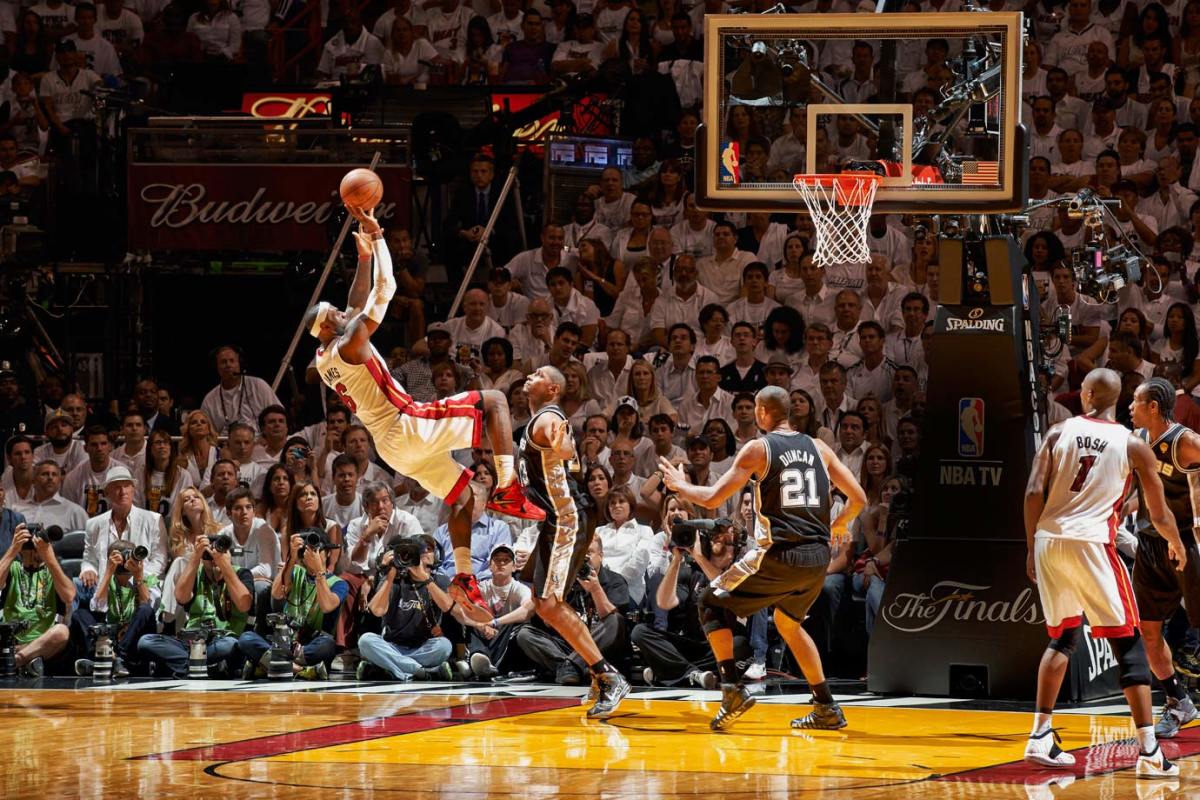
While far from his usual dominant self, LeBron James still managed to turn in a triple-double as the Heat notched a thrilling 103-100 overtime victory. Helped by Ray Allen's tying three-pointer with 5.2 seconds remaining in regulation, James overcame a couple of crucial turnovers in the final minutes to finish with 32 points, 11 assists and 10 rebounds and guide Miami to Game 7.
LeBron James | Game 5, 2012

Following a triple-double of 26 points, 13 assists and 11 rebounds that was representative of his play throughout the Finals, LeBron James won his first championship after nine seasons in the NBA. Two years earlier, he was vilified for the way he left Cleveland, and for believing that winning the championship would take care of itself now that he was playing with Dwyane Wade and Chris Bosh. One year earlier, he watched Dirk Nowitzki redeem his own career with a championship earned at James' expense. But in 2012, LeBron got his title and was named MVP of the Finals in the process.
Dirk Nowitzki | Game 2, 2011

Dirk Nowitzki shook off an injury to his non-shooting hand and made the tie-breaking layup with 3.6 seconds left in regulation, and the Mavs roared back from a 15-point deficit in the fourth quarter to stun the Heat 95-93 and tie the series at one game apiece.
Dwyane Wade | Game 3, 2006

Miami lost the first two games and trailed Dallas 89-76 in Game 3. But Dwyane Wade scored 12 of his 42 points during a game-ending 22-7 run as Miami won 98-96, the first of its four consecutive victories en route to the franchise's first championship. Wade was named Finals MVP after averaging 34.7 points, 7.8 rebounds, 3.8 assists and 2.7 steals.
Robert Horry | Game 5, 2005

Robert Horry came off the bench to score all 21 of his points after halftime against the Pistons, including the game-winning three-pointer with 5.8 seconds left in overtime. The shot gave the Spurs a 3-2 series lead, and they won the title in seven.
Michael Jordan | Game 6, 1998
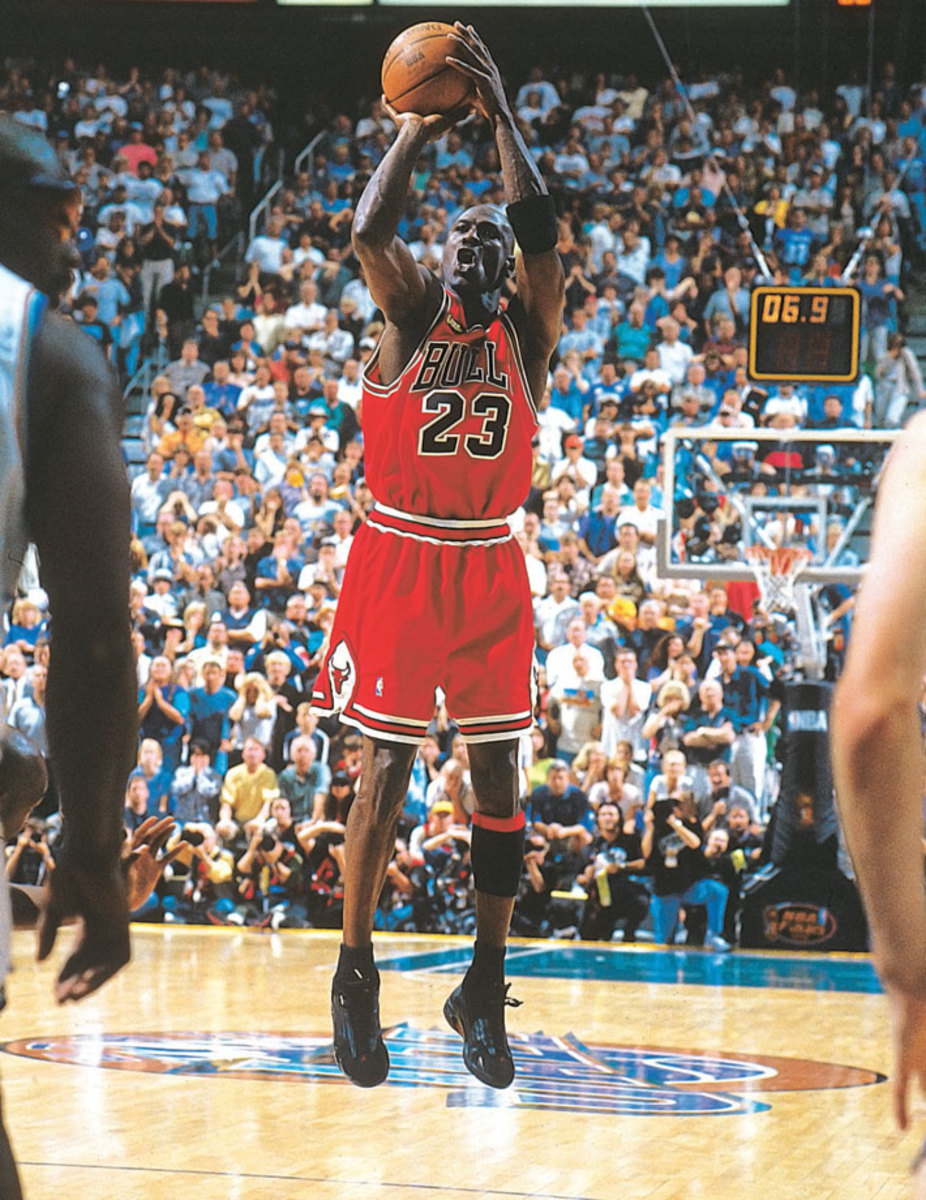
Michael Jordan scored 45 points and capped his Chicago career with a last-second jumper over Utah's Bryon Russell that clinched the Bulls' sixth title in eight seasons.
Michael Jordan | Game 5, 1997

Michael Jordan fought off an energy-zapping flu bug to get 38 points, seven boards and five assists -- including the game-winning shot with 25 seconds left. Chicago went on to win its fifth championship in seven seasons.
Steve Kerr | Game 6, 1997

Four years after another sharpshooter (John Paxson) provided the Finals-winning jump shot for the Bulls in a Game 6 (at Phoenix), Steve Kerr did the same with a mid-range J against the Jazz in Chicago.
Rockets vs. Knicks | Game 3, 1994

Hakeem Olajuwon and Patrick Ewing toiled in the NBA for 19 combined seasons before reaching these Finals. They were upstaged during Game 3, however, when NBC preempted Rockets-Knicks coverage to air police chasing O.J. Simpson down a Southern California freeway.
John Paxson | Game 6, 1993
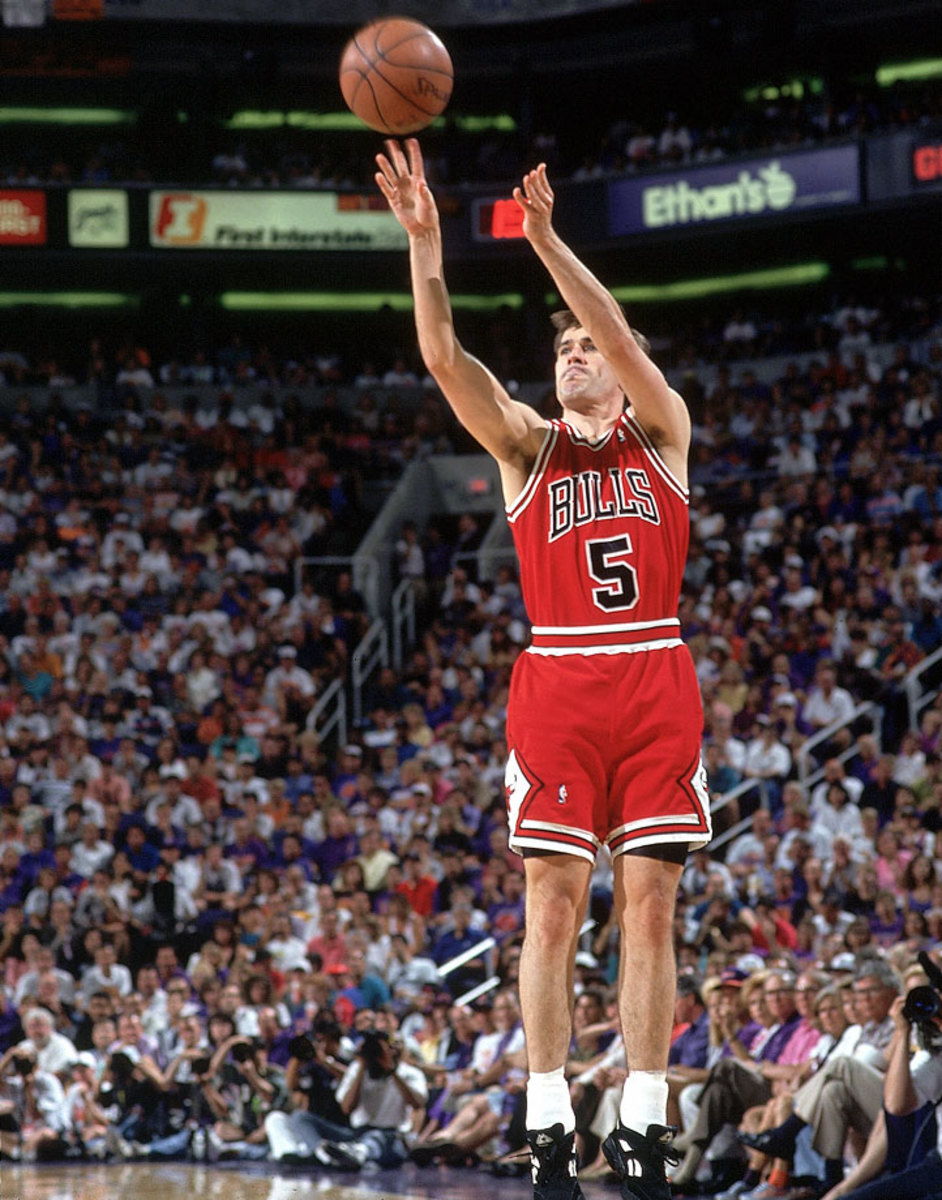
John Paxson's game-winning three-pointer in Phoenix gave the Bulls their third consecutive championship.
Michael Jordan | Game 1, 1992
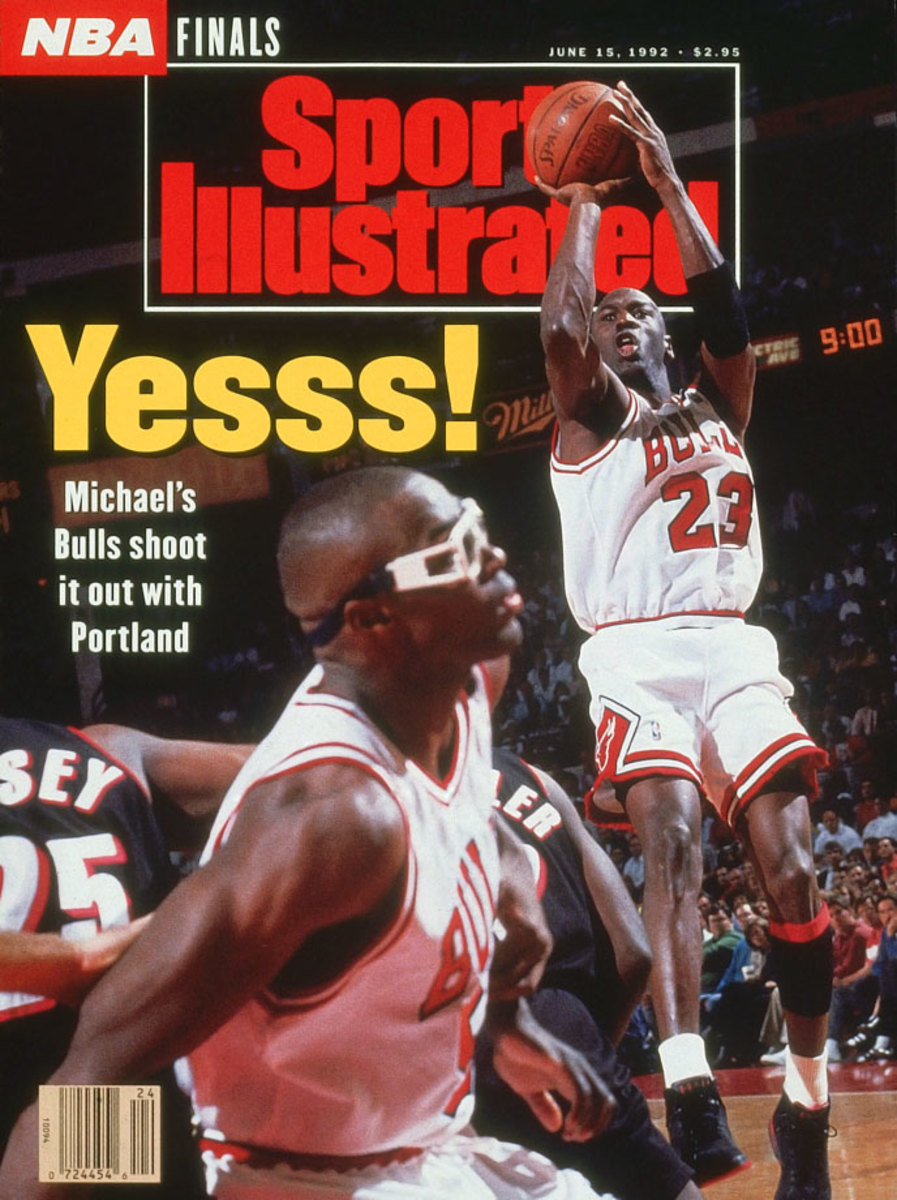
Michael Jordan hit six three-pointers and scored 35 points in the opening half against the Trail Blazers. Chicago coasted to a 122-89 victory.
Isiah Thomas | Game 6, 1988
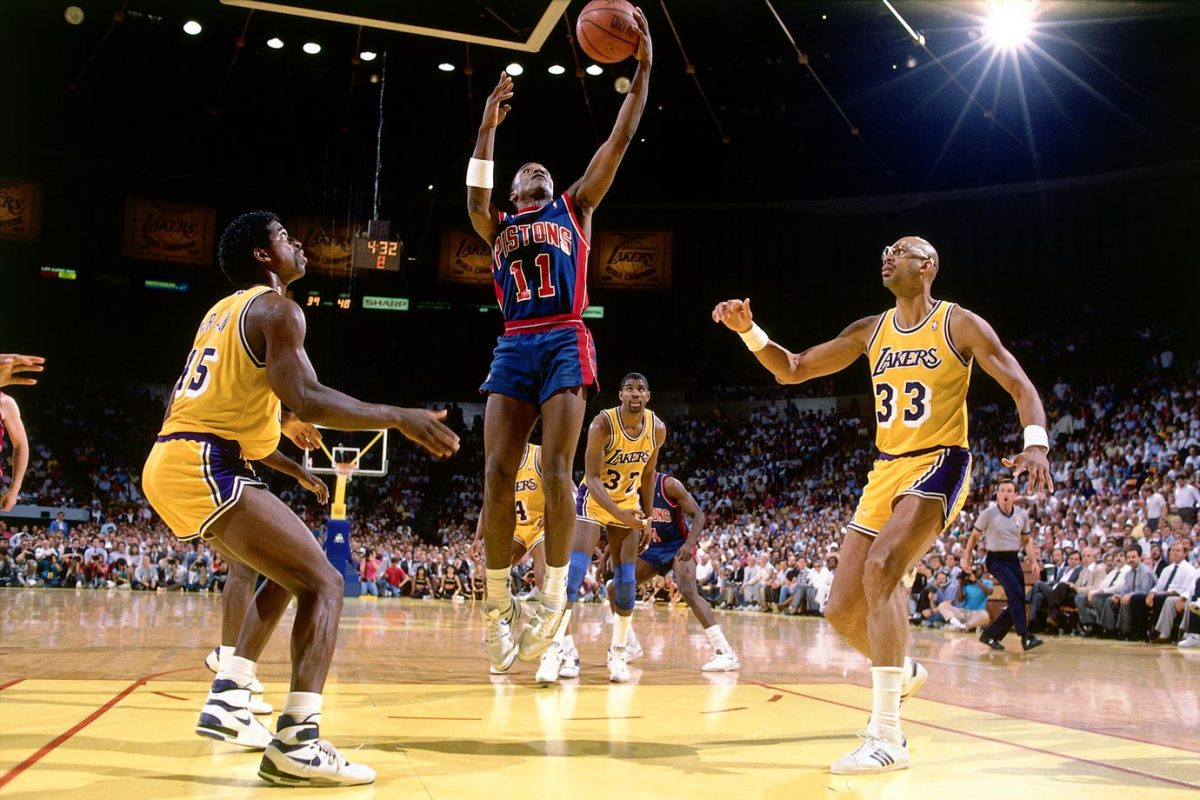
Playing on a severely sprained ankle, Isiah Thomas scored 25 points in the third quarter and almost single-handedly carried Detroit to a series-clinching victory. (The Lakers won the game and the next one, too).
Magic Johnson | Game 4, 1987
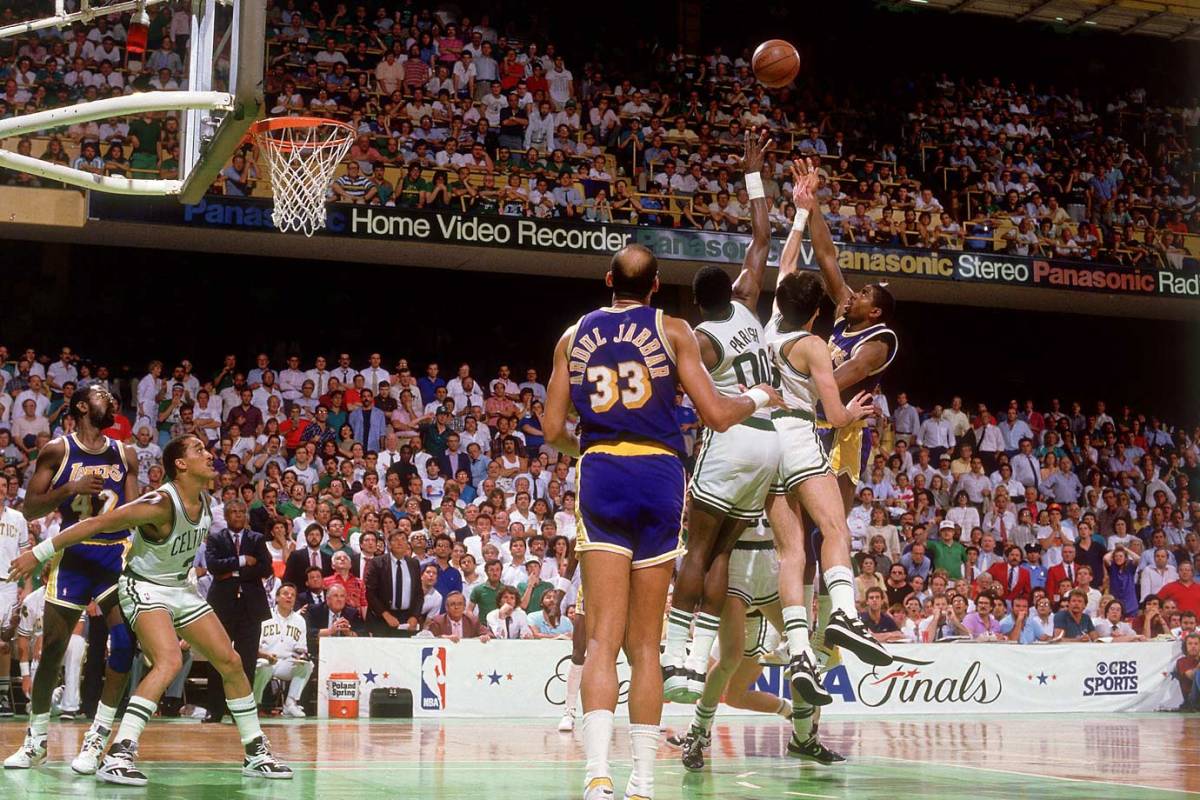
In one of the most memorable moments in Finals history, Magic Johnson won Game 4 with what he called his "junior, junior, junior sky hook." That victory in Boston gave the Lakers a 3-1 lead; they wrapped it up two games later in Los Angeles, where 39-year-old Kareem Abdul-Jabbar scored 32 points and Magic closed with 16 points, 19 assists and eight rebounds. Johnson became the fourth player to win the regular-season and Finals MVP awards.
Ralph Sampson | Game 5, 1986

Ralph Sampson brawled with Boston guard Jerry Sichting (inset) early in the game and subsequently cursed in a live interview with CBS just moments after both players were ejected. The Rockets then routed the Celtics to extend the series to a sixth game. The Celtics won Game 6 at Boston Garden to claim their 16th championship.
Gerald Henderson | Game 2, 1984

The Lakers had the Celtics on the ropes, leading the series 1-0 and nursing a 115-113 advantage with 15 seconds left in Game 2. But Gerald Henderson picked off James Worthy's lazy backcourt pass and turned it into a game-tying layup. Boston prevailed in overtime to climb back into the series.
Julius Erving | Game 4, 1980

Dr. J's out-of-this-world reverse layup against the Lakers is still hailed by Magic Johnson as the greatest play he's ever seen.
Magic Johnson | Game 6, 1980

To offset Kareem Abdul-Jabbar's ankle injury, Magic Johnson moved to center and guided the undersized Lakers to a championship-clinching road win over the 76ers. The rookie Johnson scored 42 points and grabbed 15 boards.
Gar Heard | Game 5, 1976

Suns forward Gar Heard nailed a turnaround 22-footer at the buzzer to force a third overtime. Heard's improbable shot helped put the Celtics' 128-126 victory in the conversation of the greatest games in NBA history.
Walt Frazier | Game 7, 1970

An injured Willis Reed (inset) made a dramatic entrance and scored two immediate baskets, further energizing the crowd at Madison Square Garden. He then watched Frazier (pictured, 36 points, 19 assists) and the Knicks throttle the Lakers to win the championship.
Jerry West | Game 3, 1962; Game 3, 1970

The Logo was a postseason force, including being named the 1969 Finals MVP even though the Lakers lost the series to Boston. Two more signature moments: his steal and game-winning layup to give the Lakers a 2-1 series lead in 1962 (Boston won it in seven); and his buzzer-beating 60-footer (inset) to force overtime against the Knicks in '70 (New York won the game and the series, forcing West to wait two more years for his first and only title).
Elgin Baylor | Game 5, 1962

Baylor erupted for a Finals-record 61 points and grabbed 22 boards as the Lakers won 126-121 at Boston Garden to take a 3-2 series lead. But the Celtics rallied to win Games 6 and 7 (including a 110-107 OT victory in the clincher) in a classic first Finals meeting between L.A. and Boston.
Bill Russell | Game 7, 1962

In one of the greatest winning-take-all games in NBA history, the Celtics beat the Lakers 110-107 in overtime behind Bill Russell's 30 points and 40 rebounds. Bob Cousy memorably dribbled out the clock.
Bob Pettit | Game 6, 1958
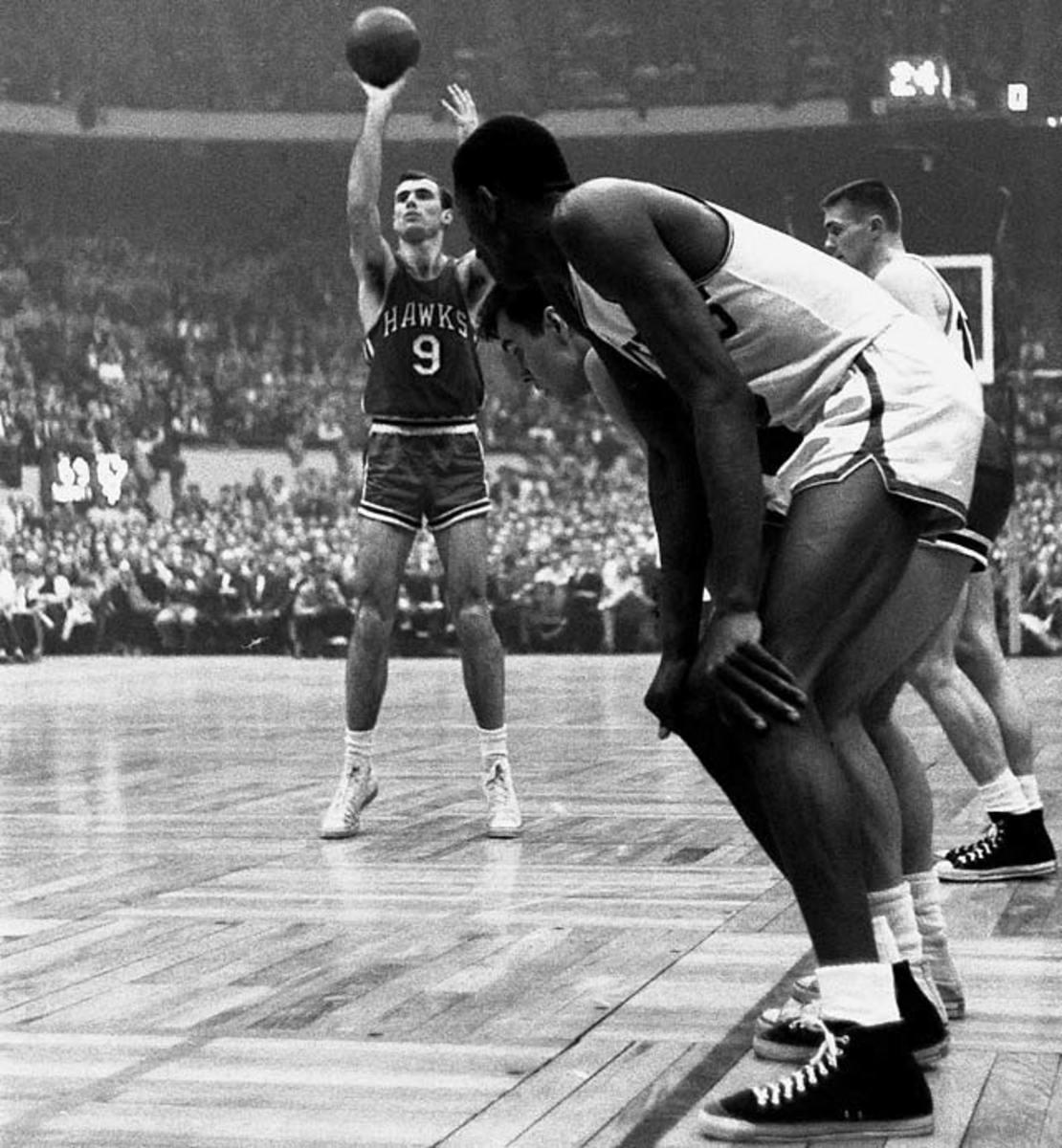
The St. Louis forward scored 50 points (including 19 in the fourth quarter) in his team's title-clinching win against the Celtics.
